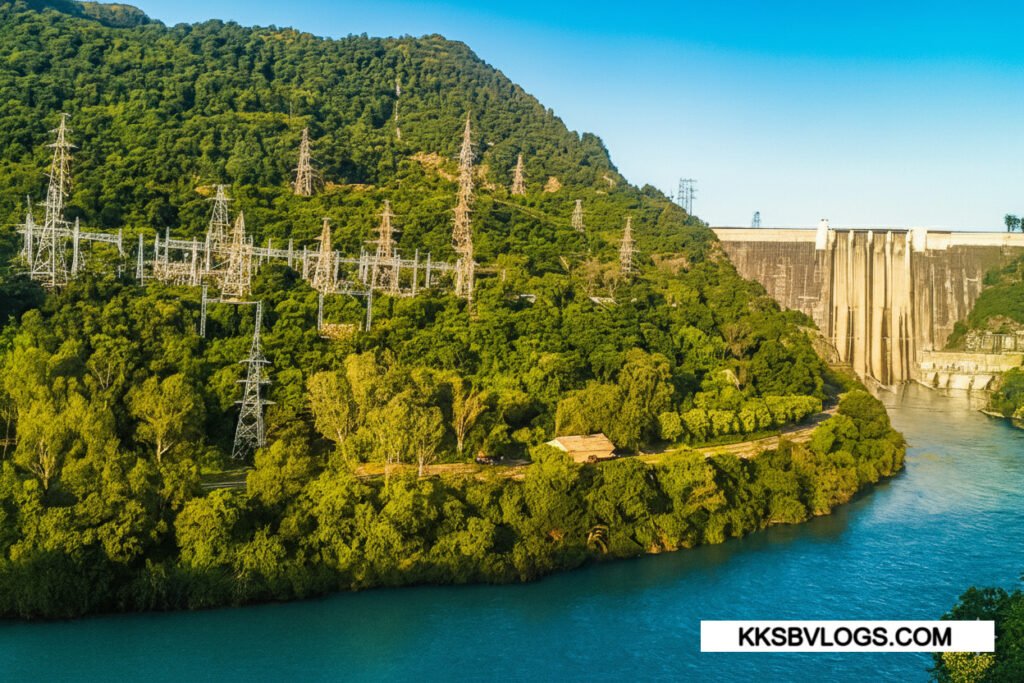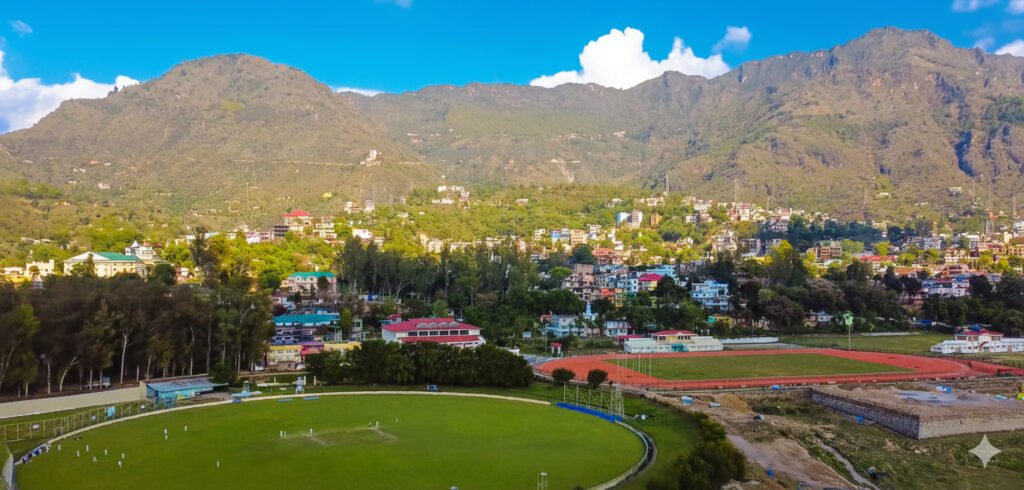1. Introduction
Nestled in the Bilaspur district of Himachal Pradesh, the Bhakra Dam is a man-made marvel of engineering and vision, often called the “Temple of Modern India” by India’s first Prime Minister, Pandit Jawaharlal Nehru.
Built across the mighty Sutlej River, the dam rises to an astonishing height of about 226 metres (741 ft) and stretches over 520 metres in length, making it one of Asia’s tallest gravity dams.
More than an engineering achievement, Bhakra Dam is a symbol of India’s progress and self-reliance.
It provides hydroelectric power, irrigation, drinking water supply, and flood control, supporting millions of people across Himachal Pradesh, Punjab, Haryana, Rajasthan, and Delhi.
Its reservoir, the Gobind Sagar Lake, is counted among the largest man-made lakes in Asia, holding up to 9.34 billion cubic metres of water.
For travelers, Bhakra Dam offers something for everyone.
- Nature lovers are drawn to the lake’s calm blue waters and the emerald Shivalik hills that surround it.
- Photography enthusiasts can capture unforgettable sunrise and sunset reflections.
- History buffs and engineering students find inspiration in its story of post-independence nation-building.
Visiting Bhakra Dam is more than sightseeing — it’s an experience of technology, natural beauty, and cultural heritage in one place.
2. History & Construction of Bhakra Dam
2.1 Vision & Early Planning
The concept of Bhakra Dam dates back to the British colonial period, but political will and resources delayed its start.
Only after India’s independence in 1947 did the idea become reality.
In 1948, construction began under the vision of Pandit Jawaharlal Nehru, who saw such projects as the “temples of modern India”—symbols of a new nation’s industrial and agricultural strength.
The dam was designed to serve multiple purposes:
- Irrigation for Punjab, Haryana, and Rajasthan to boost food production.
- Hydroelectric power generation to drive factories and cities.
- Flood control to protect villages and farmlands along the Sutlej River.
2.2 Major Milestones
Construction of this mega project was a monumental feat for newly independent India.
Work began in 1948 and continued for 15 years, finally completing in 1963.
During this time, thousands of engineers, technicians, and labourers worked through harsh weather and challenging terrain to build what was then the world’s tallest gravity dam.
The Bhakra project stands as a shining example of Nehruvian industrial vision, where technology, planning, and national development converged.
It transformed barren lands into fertile fields and inspired many more infrastructure projects across India.
2.3 Social & Economic Impact
The completion of Bhakra Dam was a turning point in India’s agricultural history, giving a major push to the Green Revolution.
Canal irrigation brought water to dry regions of Punjab, Haryana, and Rajasthan, dramatically increasing crop yields and helping India move towards food security.
Economically, the dam powers a hydroelectric network managed by the Bhakra Beas Management Board (BBMB), supplying electricity to Himachal Pradesh, Punjab, Haryana, Delhi, and Rajasthan.
The fisheries and tourism industries around Gobind Sagar Lake also thrive because of it.
Even today, Bhakra Dam continues to drive regional development and stands as a symbol of post-independence resilience and progress.
3. Architecture & Engineering Marvel
The Bhakra Dam is not just an imposing structure of concrete; it is a masterclass in engineering and design.
It is a gravity dam, meaning it resists the tremendous water pressure of the Sutlej River solely by its own weight, a design chosen for its unmatched strength and durability.
Dimensions & Structure
- Height: ~226 m (741 ft)
- Length: ~520 m
- Base Width: ~30 m, tapering to ~12 m at the top
These proportions ensure the dam’s immense stability and earthquake resistance, allowing it to safely hold back billions of cubic metres of water.
Gobind Sagar Lake – A Giant Reservoir
The construction of Bhakra Dam gave birth to the Gobind Sagar Lake, a 90 km long and 9.34 billion cubic metre reservoir named after Guru Gobind Singh Ji.
This lake not only supplies drinking and irrigation water but also feeds power stations that light up homes and industries across North India.
Hydroelectric Power House
Beneath the dam lies a state-of-the-art powerhouse that generates around 1,200 MW of electricity.
The Bhakra Beas Management Board (BBMB) ensures that this clean energy is efficiently distributed to Punjab, Haryana, Himachal Pradesh, and Delhi, making the dam one of India’s most vital hydroelectric hubs.
Safety & Design
Engineers equipped Bhakra Dam with earthquake-resistant construction, a multi-gate spillway system, and emergency flood controls.
These features ensure that even during heavy monsoons or sudden water surges, the Sutlej River’s flow is safely managed, protecting surrounding settlements and farmland.
The massive concrete wall, modern turbines, and sparkling reflections of Gobind Sagar Lake together create an experience where technology and nature meet in perfect harmony.
For architecture lovers, engineering students, and curious travelers, Bhakra Dam feels like a living classroom and a breathtaking natural wonder combined.
4. Natural Beauty & Surroundings
The Bhakra Dam is not only a masterpiece of engineering but also a paradise of natural beauty.
With the majestic Gobind Sagar Lake stretching behind it and the green Shivalik hills framing its horizon, the area offers some of Himachal Pradesh’s most stunning landscapes.
Gobind Sagar Lake – A 90 km Blue Jewel
Created by the dam itself, the Gobind Sagar Lake is one of Asia’s largest man-made reservoirs.
Its emerald-blue waters mirror the surrounding forests and mountains, changing colour through the day.
- Morning: Soft silver-gold reflections with mist dancing on the water.
- Afternoon: Bright turquoise hues with clear mountain shadows.
- Sunset: Pink, orange, and purple streaks turning the lake into a giant painting.
The calm surface of the lake is perfect for boating, shikara rides, and tranquil nature photography, making it a dream destination for photographers and peace-seekers.
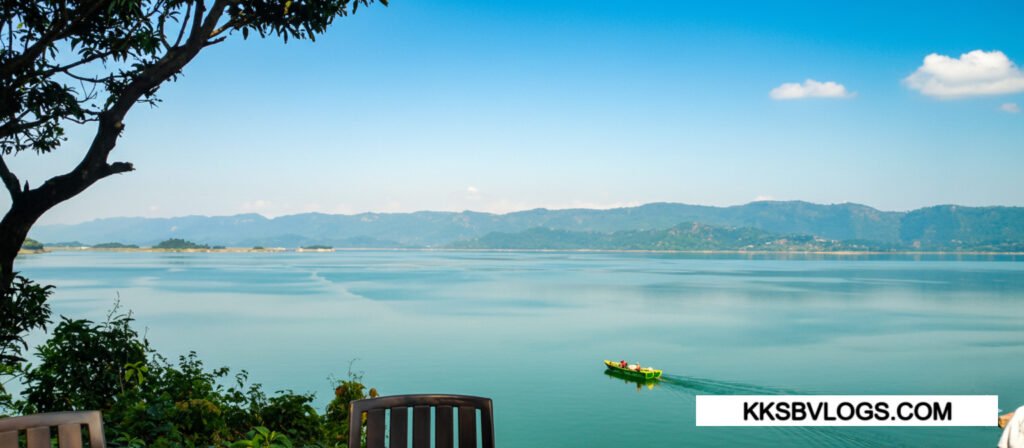
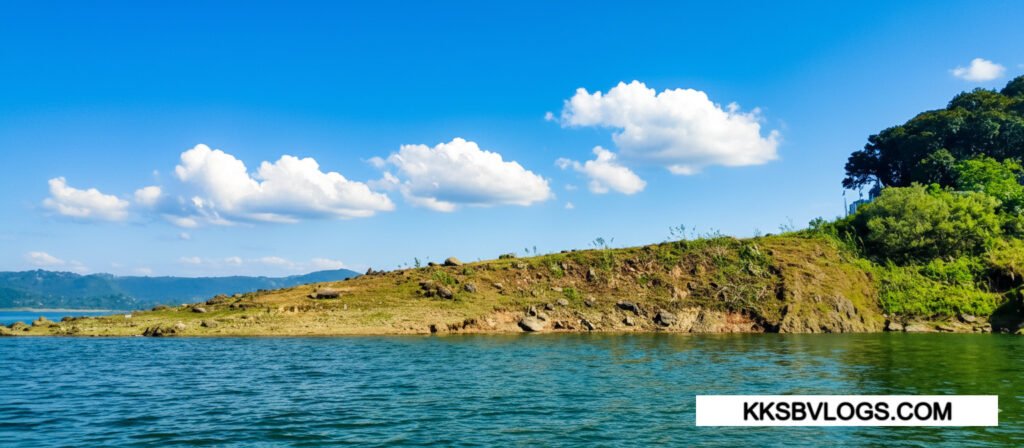
Flora & Forests – Living Green Walls
The surroundings of Bhakra Dam are wrapped in lush deodar, pine, and ban (oak) forests.
These trees act as natural green walls, offering fresh oxygen and a cooling breeze year-round.
Every season paints the forest in a new palette:
- Spring: Fresh, bright greens with wildflowers blooming.
- Monsoon: Deep emerald shades with misty clouds.
- Winter: Golden-brown textures highlighted by soft sunlight.
The scent of pine and wild herbs fills the air, creating a natural spa-like atmosphere.
Wildlife & Birdwatching
Bhakra Dam is a haven for birdwatchers.
During winter months, migratory birds from Central Asia and Siberia—like kingfishers, pochards, herons, and storks—flock to the Gobind Sagar Lake.
Their presence adds life and movement to the serene waters.
Photographers and nature enthusiasts will find endless opportunities for close-up shots of rare species.
Mountain Viewpoints & Scenic Ridges
From the top of the dam and nearby ridges, you can enjoy panoramic 360° views of the Shivalik mountain ranges, Naina Devi Hills, and valleys dotted with villages and orchards.
On a clear day, the faraway Himalayan foothills appear like faint blue shadows against the sky.
Whether it’s sunrise or sunset, the changing colours and long mountain shadows make every viewpoint breathtaking.
5. Things to Do at Bhakra Dam
A trip to Bhakra Dam in Bilaspur Himachal Pradesh is far more than a simple sightseeing stop.
It’s a blend of adventure, education, and natural relaxation.
Whether you are an engineering student, a photography lover, or a family traveler, you will find something here that matches your interest.
Dam-View Galleries & Guided Engineering Tour
The viewing galleries at the dam-top give breathtaking sights of Gobind Sagar Lake and the mighty Sutlej River.
The sheer scale of the 226 m-high concrete wall is awe-inspiring, especially when you hear the distant roar of the spillway gates releasing water.
With prior permission, visitors can also take a guided tour of the powerhouse and control rooms.
Here you can see giant turbines in action, learn about the hydroelectric process, and talk to BBMB engineers about how this dam powers large parts of northern India.
For engineering and architecture students, it feels like a live classroom with nature as the blackboard.
Photography – Sunrise & Sunset Magic
Photography at Bhakra Dam is an unforgettable experience.
- Sunrise: Gentle silver light reflects on Gobind Sagar Lake with misty hills behind.
- Daytime: Bright blue skies highlight the massive grey wall of the dam and deep-green forests.
- Sunset: The lake glows in orange, pink, and purple shades, creating a painterly backdrop.
Whether you shoot with a professional camera or a smartphone, you’ll capture frame-worthy pictures of water reflections, migrating birds, and the impressive engineering structure.
🚤 Boating on Gobind Sagar Lake
Behind the dam lies the serene Gobind Sagar Lake, perfect for boating and shikara rides.
Sailing across the 90 km-long reservoir, you can see dense pine forests, faraway mountain ridges, and flocks of migratory birds.
The gentle ripples of the emerald water and cool mountain breeze make this one of the most peaceful experiences in Himachal Pradesh.
For families, paddle boats and speed boats are easily available at boating points like Luhnu Ground and Doba.
Evenings are particularly magical for a sunset boat ride.

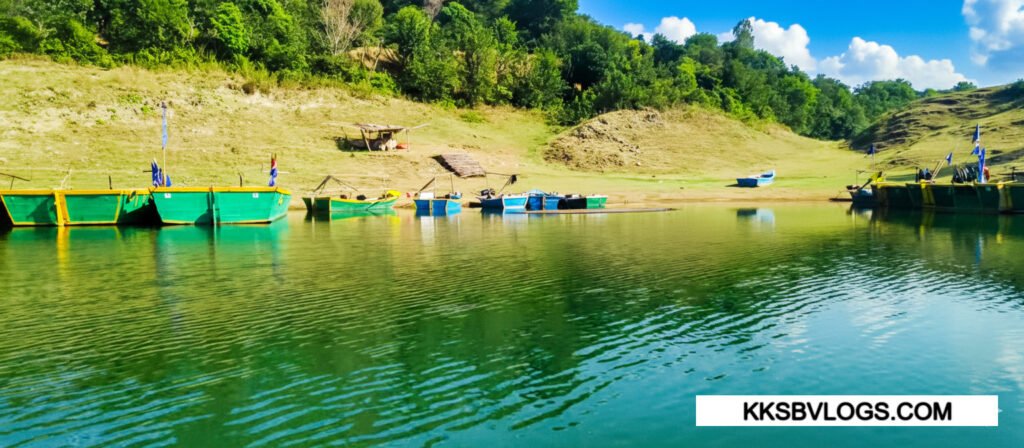
Fishing & Angling
For those who enjoy fishing, Gobind Sagar Lake is a hidden paradise.
With a valid Himachal Fisheries permit, you can try catching Mahseer, Rohu, and Catla.
Watching local fishermen at work is also a great way to connect with the traditional water culture of Bilaspur.
Picnic & Nature Walks
Himachal Tourism has developed beautiful gardens and picnic areas around Bhakra Dam.
Families and groups can enjoy packed lunches, quiet reading time, or simply relax in the fresh mountain air.
Lakeside trails let you walk through pine forests, where the mix of forest fragrance and cool breeze feels like a natural spa.
✨ Why Visitors Love Bhakra Dam
A single trip here gives you multiple experiences in one place:
- Adventure (boating, fishing)
- Education (guided power house tours)
- Nature therapy (birdwatching, forest walks)
- Photography opportunities that are unmatched in Himachal Pradesh.
This is why Bhakra Dam remains one of the best travel destinations in Bilaspur Himachal Pradesh, attracting families, students, photographers, and peace-seekers alike.
6. Best Time to Visit Bhakra Dam
Bhakra Dam and Gobind Sagar Lake are beautiful year-round, but each season brings a different charm.
Here’s a clear guide to help you plan the perfect visit.
| Season | Temperature (Approx.) | Highlights & Travel Experience |
|---|---|---|
| March – June (Spring & Summer) | 18 – 30 °C | The best time for boating on Gobind Sagar Lake, dam-top photography, and forest walks. Skies stay crystal clear, giving breathtaking Shivalik range views and great sunrise shots. |
| July – September (Monsoon) | 20 – 24 °C | The lake is fullest and most dramatic. Surrounding forests turn deep emerald and misty. If spillway gates open, visitors can witness a spectacular waterfall-like discharge. Carry a raincoat and non-slip shoes. |
| October – November (Autumn) | 12 – 20 °C | Golden post-monsoon light and cool air create perfect conditions for long-distance photography. Migratory birds start arriving, making it ideal for birdwatching and quiet lakeside picnics. |
| December – February (Winter) | 5 – 15 °C | Peaceful and crowd-free, perfect for those seeking calm and meditation. Early mornings bring fog over the lake, creating dreamlike scenes for photographers. Carry warm jackets and thermos for tea/coffee. |
✨ Travel Tips
- Early morning (6:30 – 9:30 am) is ideal for dam-top views and bird photography.
- Sunset boat rides are magical, with the sky and lake glowing in orange-pink hues.
- During monsoon, check weather updates; heavy rain may temporarily restrict boating or guided tours.
- Winters can be chilly, so pack warm clothing and gloves.
Visiting Bhakra Dam Bilaspur Himachal Pradesh during any season promises engineering marvels, natural beauty, and serene moments, but timing your trip to your interests (boating, photography, birdwatching) will help you get the most out of this incredible destination.
7. How to Reach Bhakra Dam
Reaching Bhakra Dam Bilaspur Himachal Pradesh is convenient from Chandigarh, Delhi, Punjab, and Himachal’s hill towns. Whether you prefer a scenic road trip, train journey, or flight, there are multiple easy options.
By Road – Most Convenient & Scenic
- From Bilaspur Town: About 88 km (1–1.5 hrs). Local taxis and HRTC buses regularly take visitors right up to the dam’s entry gate.
- From Chandigarh: Roughly 127 km (4–5 hrs) via NH205 through Kiratpur Sahib and Swarghat. The drive is memorable, with the first glimpse of Gobind Sagar Lake appearing along winding mountain roads.
- From Delhi: Around 330 km (8–9 hrs) via NH44 + NH205. Overnight Volvo buses or private cabs are convenient for families and groups.
By Train
The nearest broad-gauge railway stations are:
- Kiratpur Sahib: ~44 km
- Anandpur Sahib: ~35 km
From either station, travelers can hire a taxi or catch an HRTC bus to Bilaspur and onward to the dam.
By Air
The closest airport is Chandigarh International Airport (IXC), about 135 km away.
From the airport, you can:
- Book a direct cab to Bhakra Dam (approx. 4–5 hrs).
- Or take a Volvo/HRTC bus to Bilaspur and then a local taxi.
Local Connectivity
- Parking: Official parking is available near the dam entrance.
- Permissions: Entry is free, but ID proof is required and security checks are strict.
- Guided Tours: For powerhouse and control-room visits, get prior approval from the Himachal Tourism office or BBMB authorities.
✨ Travel Tip:
Start early in the morning to avoid traffic and to enjoy Gobind Sagar Lake’s sunrise views right from the road.
8. Visitor Information – Bhakra Dam
Before planning a trip, it’s helpful to know these important facts and practical details about Bhakra Dam Bilaspur Himachal Pradesh:
- Entry Timings:
- Summer: 9:00 am – 6:00 pm
- Winter: 9:00 am – 5:00 pm
(Timings may vary slightly due to security or weather.)
- Entry & Security:
- Entry is free, but ID proof is mandatory.
- Security checks at the main gate are strict to ensure visitor safety.
- Photography Rules:
- Limited photography is allowed on the dam-top.
- Inside the powerhouse and control room, photography is restricted.
- Boating & Activities:
- Gobind Sagar Lake boating stations (e.g., Luhnu Ground, Doba) operate from 9 am – 6 pm.
- Choose between paddle boats, shikaras, or speed boats for different experiences.
- Food & Facilities:
- Several tea stalls, dhabas, and small Himachali food points serve simple, fresh meals.
- Clean drinking water and well-maintained washrooms are available at visitor areas.
- Stay Options:
- Bilaspur town offers hotels, guesthouses, and homestays to fit every budget.
- For nature lovers, Gobind Sagar lakeside camping and forest rest houses (bookable via Himachal Tourism) provide a rustic experience.
- Safety Reminder:
- During monsoon, when spillway gates open, certain areas may be restricted.
- Follow staff instructions and wear a life jacket when boating.
9. Our Experience – Bhakra Dam
Every visit to Bhakra Dam feels like stepping into a world where engineering excellence meets raw natural beauty.
On our most recent trip, the experience began the moment we left Bilaspur town early in the morning.
As the road curved through pine-filled hills, the first glimpse of Gobind Sagar Lake appeared—its shimmering blue surface glowing softly in the morning light, instantly heightening our excitement.
The entry gate welcomed us with cool mountain air and the distant roar of water.
After a quick security check, we drove to the dam-top viewing gallery, and the sight was truly breathtaking.
Standing at the edge of the 226-metre-high concrete wall, we could feel the sheer power of the Sutlej River and the scale of human ingenuity.
The spillway gates were partly open, creating a thundering waterfall effect and a deep natural rumble that echoed across the Shivalik hills.
Next came the guided powerhouse tour, an unmissable highlight.
Inside the cool, humming chambers below the dam, giant turbines worked tirelessly, producing clean hydroelectric energy that lights up homes and industries across Himachal, Punjab, Haryana, and Delhi.
Listening to BBMB engineers explain how the power control systems operate felt like sitting in a live engineering classroom.
We then headed to the lakefront for boating.
Gliding across the emerald waters of Gobind Sagar Lake, surrounded by green hills and occasional calls of kingfishers and migratory birds, was pure peace.
The reflections of pine forests on the water were so perfect they looked like a painting.
As the sun began to set, the lake turned gold and rose-pink, creating a picture-perfect frame for photography lovers.
The day ended with chai and local snacks at a lakeside dhaba, where the aroma of Himachali spices mixed with fresh mountain breeze.
Looking back at the majestic dam silhouetted against a flaming sunset, it was hard not to feel inspired by the vision and courage that built this “Temple of Modern India.”
Visiting Bhakra Dam Bilaspur Himachal Pradesh is far more than a sightseeing trip.
It is a multi-sensory journey—the roar of cascading water, the cool mist on your face, the hum of massive turbines, the call of Himalayan birds, and the silent expanse of Gobind Sagar Lake all come together.
Every visit deepens the appreciation of how human innovation and nature’s power can exist in perfect harmony.
10. Nearby Attractions Around Bhakra Dam
A trip to Bhakra Dam can easily become a 2–3 day Bilaspur itinerary if you include these nearby attractions, each with its own character and charm.
1. Gobind Sagar Lake
Created by the dam itself, Gobind Sagar Lake is a 82 km-long man-made reservoir known for boating, fishing, and migratory birds.
Sunrise and sunset reflections paint the water in silver, gold, and pink shades, making it a dream spot for photographers and nature lovers.
2. Mata Naina Devi Temple
Located around 30 km away on a hilltop, this Shakti Peeth is one of the most sacred temples in Himachal.
A ropeway ride offers breathtaking views of the Shivalik hills and Gobind Sagar Lake.
Morning and evening aartis fill the valley with divine chants and bells, giving visitors a spiritual high.
3. Markandeya Rishi Temple
About 87 km from Bhakra Dam, this ancient temple is associated with Rishi Markandeya’s tapasya (deep meditation) and is known for a natural healing water stream.
The last 2 km forest trail and small cave with a Hanuman shrine make the visit both spiritual and adventurous.
4. Bahadurpur Hill & Fort
, Bahadurpur Hill is Bilaspur’s highest peak (~1,980 m).
A 6–8 km moderate trek through oak and deodar forests leads to the ruins of an ancient fort and a 360° panoramic view of Gobind Sagar Lake, Naina Devi Hills, and distant Shimla ranges—ideal for trekkers and photographers.
5. Kandrour Bridge
Kandrour Bridge is one of Asia’s highest steel suspension bridges built over the Sutlej River.
Standing here provides a spectacular view of deep-blue waters and green valleys, especially stunning during sunset.
6. Swarghat Hill Station
Situated on the Bilaspur–Chandigarh highway, Swarghat is a peaceful hill station perfect for a tea break or an overnight stay.
Known for pine forests, mist-filled valleys, and small roadside temples, it offers calm views of the lower Himalayan ranges.
11. Bhakra Dam Location, Photos & Video
YouTube Video:Coming soon on – KKSB Vlogs
Instagram Updates: Stay connected with us for reels and updates– @official_kksb
Bhakra Dam Photos


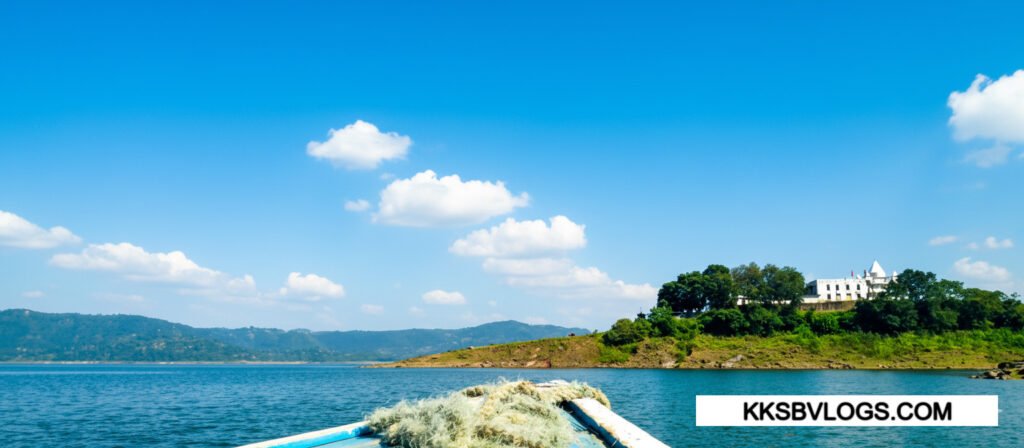

Bhakra Dam Location
12. FAQs – Bhakra Dam Bilaspur Himachal Pradesh ❓
Where is Bhakra Dam located?
Bhakra Dam is located on the Sutlej River in Bilaspur district, Himachal Pradesh, about 130 km from Chandigarh and 320 km from Delhi. Behind it lies the beautiful Gobind Sagar Lake.
What is the height and length of Bhakra Dam?
It is Asia’s highest gravity dam, standing about 226 meters tall and 520 meters long. Its base is around 30 m wide, tapering to 12 m at the top, making it exceptionally strong and earthquake-resistant.
What is the history of Bhakra Dam?
Construction began in 1948 and was completed in 1963. India’s first Prime Minister Pandit Jawaharlal Nehru called it a “Temple of Modern India” because it revolutionized irrigation, electricity production, and flood control in northern India.
What is the name of the lake formed behind Bhakra Dam?
The reservoir is called Gobind Sagar Lake, named in honor of Guru Gobind Singh Ji. It is among Asia’s largest man-made lakes, famous for boating, fishing, birdwatching, and sunrise–sunset photography.
What is the best time to visit Bhakra Dam?
March to June is best for boating and photography. October to February offers calm weather and the chance to see migratory birds. During monsoon, open spillway gates create a dramatic waterfall effect.
How can one reach Bhakra Dam?
From Bilaspur town it is about 35 km by taxi or HRTC bus. From Chandigarh, take NH205 via Kiratpur Sahib (4–5 hours). The nearest railway stations are Anandpur Sahib (90 km) and Kiratpur Sahib (75 km), and the closest airport is Chandigarh (135 km).
Is a guided tour inside Bhakra Dam available?
Yes. With prior permission, visitors can take a guided tour of the powerhouse and control room, watch giant turbines in action, and learn about hydroelectric generation—ideal for engineering and science enthusiasts.
Are boating and fishing allowed at Bhakra Dam?
Absolutely. Gobind Sagar Lake offers paddle boats, shikaras, and speed boats. Fishing and angling are also possible with a permit, where species like Mahseer, Rohu, and Catla can be caught.
What safety measures should visitors follow at Bhakra Dam?
Carry valid ID proof for entry. Security checks are strict. Avoid restricted areas when spillway gates are open in monsoon, and always wear a life jacket while boating.
What stay and food options are near Bhakra Dam?
Nearby Bilaspur town has hotels, guesthouses, and homestays for all budgets. Around the dam, you’ll find tea stalls and Himachali dhabas for fresh local meals. Nature lovers can book Gobind Sagar lakeside camping spots through Himachal Tourism.

